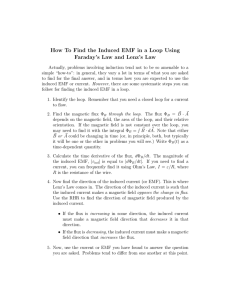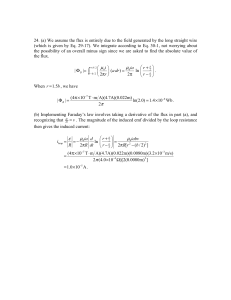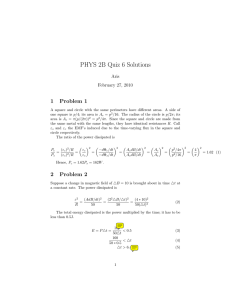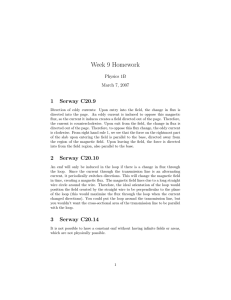Chapter 29 Solutions
advertisement
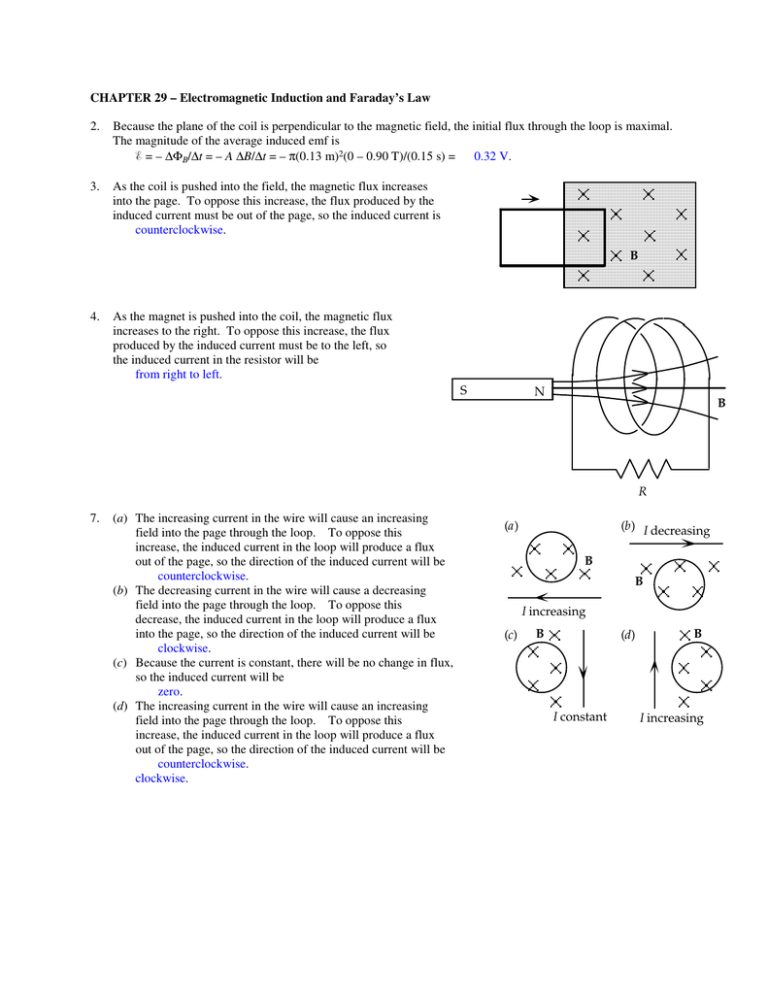
CHAPTER 29 – Electromagnetic Induction and Faraday’s Law 2. Because the plane of the coil is perpendicular to the magnetic field, the initial flux through the loop is maximal. The magnitude of the average induced emf is = – ∆ΦB/∆t = – A ∆B/∆t = – π(0.13 m)2(0 – 0.90 T)/(0.15 s) = 0.32 V. 3. As the coil is pushed into the field, the magnetic flux increases into the page. To oppose this increase, the flux produced by the induced current must be out of the page, so the induced current is counterclockwise. B 4. As the magnet is pushed into the coil, the magnetic flux increases to the right. To oppose this increase, the flux produced by the induced current must be to the left, so the induced current in the resistor will be from right to left. S N B R 7. (a) The increasing current in the wire will cause an increasing field into the page through the loop. To oppose this increase, the induced current in the loop will produce a flux out of the page, so the direction of the induced current will be counterclockwise. (b) The decreasing current in the wire will cause a decreasing field into the page through the loop. To oppose this decrease, the induced current in the loop will produce a flux into the page, so the direction of the induced current will be clockwise. (c) Because the current is constant, there will be no change in flux, so the induced current will be zero. (d) The increasing current in the wire will cause an increasing field into the page through the loop. To oppose this increase, the induced current in the loop will produce a flux out of the page, so the direction of the induced current will be counterclockwise. clockwise. (a) (b) I decreasing B B I increasing (c) B (d) I constant B I increasing 8. (a) As the resistance is increased, the current in the outer loop will decrease. Thus the flux through the inner loop, which is out of the page, will decrease. To oppose this decrease, the induced current in the inner loop will produce a flux out of the page, so the direction of the induced current will be counterclockwise. (b) If the small loop is placed to the left, the flux through the small loop will be into the page and will decrease. To oppose this decrease, the induced current in the inner loop will produce a flux into the page, so the direction of the induced current will be clockwise. I B 15. For the resistance of the loop, we have R = ρL/A = ρπD/ πd2 = 4ρD/d2. The induced emf is = – ∆ΦB/∆t = – πD2 ∆B/∆t; so the induced current is I = /R = – (πDd2/16ρ) ∆B/∆t. In the time ∆t the amount of charge that will pass a point is Q = I ∆t = – (πDd2/16ρ) ∆B = – [π(0.156 m)(2.05 × 10–3 m)2/16(1.68 × 10–8 Ω · m)](0 – 0.550 T) = 4.21 C. 16. The flux through a loop is ΦB = [(8.8 s–1)t – (0.51 s–3)t3] × 10–2 T · m2. (a) The induced emf is = – N dΦB/dt = – (60)[(8.8 s–1) – (1.53 s–3)t2] × 10–2 T · m2 = [– 528 + (91.8 s–2)t2] × 10–2 V = – 5.3 V+ (0.92 V · s–2)t2. (b) At t = 1.0 s we have –2 2 – 4.4 V. 1 = – 5.28 V + (0.918 V · s )(1.0 s) = At t = 5.0 s we have –2 2 18 V. 5 = – 5.28 V + (0.918 V · s )(5.0 s) = 21. At a distance r from the wire, the magnetic field is directed into the paper with magnitude B = µ0I/2πr. Because the field is not constant over the square, we find the magnetic flux by integration. We choose a differential element parallel to the wire at position r with area a dr. The magnetic field through this element is constant, so the flux is a+ a µ0 I µ Ia ΦΒ = B · dA = B dA = a dr = 0 l n 2a = 2πr 2π a a B a a I µ0Ia 2π a l n 2. 25. (a) Although there is an induced emf, there is no current because there is no closed circuit. Thus the rod will move at constant speed. (b) When the circuit is completed, there will be a current. The induced emf is B v. Because the only resistance is from the rod, the current is I = B v/R. The induced current in the rod will be down. Because this current is in an outward magnetic field, there will be a magnetic force to the left, which will produce an acceleration: F = – IB = – B2 2v/R = ma = m dv/dt, or – (B2 2/mR) dt = dv/v. dr r B v We integrate to get the speed: t 0 – B2 2 dt = mR v v0 dv ; v 2 2 22 – B t = l n vv , or v = v0 e – B t/mR. mR 0 The speed eventually goes to zero. This is an application of Lenz’s law. 30. We find the rotation speed from peak = NBA ω; 120 V = (420 turns)(0.350 T)(0.210 m)2 ω, which gives ω = 18.5 rad/s = 37. We find the number of turns in the secondary from VS/VP = NS/NP ; (8500V)/(120 V) = NS/(500 turns), which gives NS = 3.54 × 104 turns. 40. We find the ratio of the number of turns from NS/NP = VS/VP = (12 × 103 V)/(220 V) = 55. If the transformer is connected backward, the role of the turns will be reversed: VS/VP = NS/NP ; VS/(220 V) = 1/55, which gives VS = 4.0 V. 42. (a) We assume 100% efficiency, so we find the input voltage from P= IPVP ; 100 W = (26 A)VP , which gives VP = 3.8 V. Because VS > VP , this is a step-up transformer. (b) For the voltage ratio we have VS/VP = (12 V)/(3.84 V) = 3.1. 2.95 rev/s.



